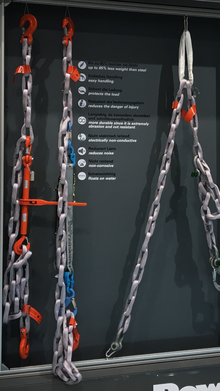Textile chain
A textile chain is a chain consisting of eight-layer webbing chain links. The textile chain links consist of the UHMWPE (Ultra-High-Molecular-Weight Polyethylene) fiber, which is marketed as “ Dyneema , the world's strongest fiber”.
application
A textile chain may - as a steel chain also - as a lashing to secure cargo or the chain sling to be used for lifting loads.
fiber
The patented Dyneema fiber has a high level of strength due to its production method using gel extrusion spinning. By manufacturing the chain links with the Dyneema fiber, a textile chain is stronger with the same weight or lighter with the same strength than alternative products such. B. steel chains.
Chain links
The chain links of a textile chain consist of wound eight-layer Möbius strips . A Möbius strip is a so-called one-sided surface that is created by twisting opposite strips and then joining them together.
With a Dyneema chain link, the webbing is laid eight times in the shape of a Möbius belt and then sewn.
Due to the Möbius design, the chain links have no top and bottom and no inner and outer ring. Due to the way of laying, the absolute length of the individual layers is the same, which leads to a reduction in the relative load differences. This in turn leads to a high breaking strength of a textile chain.
Comparison with steel chain
The advantages of a textile chain over a steel chain are its lower dead weight, the protection of the load or cargo and a lower risk of injury. Textile chains float on water, do not rust and are resistant to abrasion and cuts.
The advantages of steel chains are that they are more resistant to sharp edges and when exposed to extreme heat.
Web links
- https://www.youtube.com/watch?v=hNDgLEhAMoU
- https://www.youtube.com/watch?time_continue=52&v=jV0HK2Wt7X0
Individual evidence
- ↑ Manfred Neitzel, Peter Mitschang, Ulf Breuer: Handbook composite materials: materials, processing, application . 2nd Edition. Carl Hanser Verlag GmbH & Co. KG, Munich, ISBN 978-3-446-43696-1 , p. 39 .
- ^ DSM Dyneema. Retrieved November 28, 2017 .
- ^ Konrad Königsberger: Analysis 2 . 5th edition. Springer, ISBN 978-3-540-20389-6 , pp. 378 .
- ↑ Damien Aussems, Stein van Eden, Thessa Fokkema, Michael Gruber, Mehdi Habibi, Albert Licup, Jos van Rijssel, Anil Yalcin, Fred van Keulen, Otto Bergsma, Dietrich Wienke, and Roel Marissen, “Optimum Textile Loop Interface for a Maximum Strength of a Light Weight Synthetic Link Chain ”, Physics in Industry 2014, Lorentz Center Leiden - FOM-STW- University of Leiden
- ↑ DoNova - the textile chain. Retrieved November 28, 2017 .

